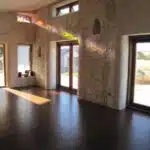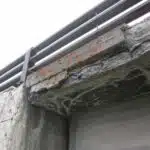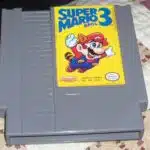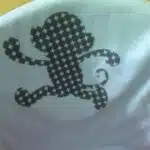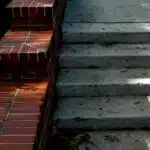Rust stains on concrete surfaces are a common problem for many homeowners and businesses. These unsightly stains can be caused by various factors such as water, metal objects, or fertilizer. Removing rust stains from concrete can be a challenging task, but with the right tools and techniques, it is possible to restore the surface to its original condition.
As a rust removal expert with years of experience in the field, I have encountered various types of rust stains on different concrete surfaces. Through my extensive research and experimentation, I have discovered effective methods for removing these stubborn stains. In this article, I will share my expertise and provide step-by-step instructions on how to remove rust stains from concrete. Whether you are a homeowner looking to improve your curb appeal or a business owner seeking to maintain a professional appearance, this guide will help you achieve your goal of having a clean and stain-free concrete surface.
Identifying The Type Of Rust Stain
Rust stains on concrete can be a stubborn nuisance to remove, but before attempting any rust removal techniques, it is important to identify the type of rust stain present. A rust stain can take many forms and colors, which can vary depending on the source of the rust. By identifying the type of rust stain on your concrete surface, you can choose an effective method for removing it without causing further damage.
One way to identify a rust stain is by its color. Rust stains can appear in shades of orange, brown, or red. The intensity of the color may also provide clues as to how long the stain has been present on the concrete surface. Fresh stains tend to be brighter in color and easier to remove than older stains that have had time to set into the concrete.
Another way to differentiate between various types of rust stains is by their source. Common sources of rust stains on concrete include metal patio furniture, tools left out in the rain, or irrigation systems that leave behind rusty water droplets. By identifying where the stain originated from, you can narrow down your options for removing it effectively and safely.
To properly prepare the surface for rust removal, it is crucial to correctly identify the type of rust stain present on your concrete surface. Once identified, you can select a method that will successfully remove the stain without damaging or discoloring your concrete surface. In order to achieve optimal results, it is essential to follow each step carefully and with patience.
Preparing The Surface For Rust Removal
- Before attempting to remove rust stains from concrete surfaces, it is important to thoroughly clean the surface to ensure that all dirt, dust, and debris are removed.
- After cleaning, a protective coating should be applied to the surface to help prevent further rust staining and to protect the surface from weathering.
- The protective coating should be applied in multiple thin layers to ensure an even coating and reduce the risk of pooling or pooling of the product.
- After allowing the protective coating to dry, any damaged areas of the concrete surface should be repaired before proceeding with the rust removal process.
Cleaning The Surface
When it comes to preparing a concrete surface for rust removal, proper cleaning is key. Using cleaning agents that are specifically formulated for concrete surfaces can help remove any dirt, grime or other debris that may have accumulated on the surface. This will allow for an optimal environment for rust removal products to work effectively.
It’s important to note that simply removing the rust stains may not be enough to fully restore the appearance of the concrete surface. Polishing the surface after rust removal can help bring back its shine and luster. This process involves using specialized machines and abrasives to smooth out any rough spots or imperfections left behind from rust stains.
Overall, taking the time to properly clean and polish a concrete surface before attempting to remove rust stains is crucial for achieving optimal results. By using appropriate cleaning agents and polishing techniques, you can ensure that your concrete surfaces look their best long after the rust has been removed.
Applying Protective Coatings
After cleaning and polishing a concrete surface to remove rust stains, it’s important to apply protective coatings to prevent future rust buildup. Choosing the appropriate coatings is crucial in ensuring long-lasting protection against rust. Epoxy coatings are often recommended as they provide a strong barrier against moisture and other environmental factors that can lead to rust formation. Other options include polyurethane and acrylic sealers, which also offer protection against rust.
Regular maintenance is key to maintaining the effectiveness of these protective coatings. This includes regular cleaning and inspections to ensure that any potential areas of rust buildup are identified early on. Additionally, reapplication of the protective coating may be necessary over time, depending on the level of wear and tear on the surface.
In conclusion, applying protective coatings after removing rust stains from a concrete surface is an essential step in preventing future rust buildup and maintaining its appearance. By choosing appropriate coatings and performing regular maintenance, you can ensure that your concrete surfaces remain free from unsightly rust stains for years to come.
Safety Precautions
After preparing the surface, it’s time to remove the rust stains. However, before proceeding with the rust removal process, it’s important to take safety precautions. Using protective gear such as gloves and goggles is necessary to avoid any harm caused by the chemicals that will be used during the removal process.
It’s crucial to read and follow the instructions on the rust remover product label carefully. Avoid mixing different products as it can result in dangerous chemical reactions. Additionally, ensure proper ventilation when using these products since they contain strong chemicals that can be harmful if inhaled.
During rust removal, it’s important to be patient as some stubborn stains may require multiple applications of the rust remover. Always test a small area first before applying the product on a larger scale. In case of accidental ingestion or skin contact with the rust remover chemicals, seek medical attention immediately.
Next, we’ll discuss choosing the right rust remover for your concrete surface based on its severity and type of stain.
Choosing The Right Rust Remover
When removing rust stains from concrete, it is important to know the different types of rust removers available. Common rust removers include chemical-based products, mechanical abrasives, and natural rust removers. It is also important to consider safety when using rust removers, such as wearing protective gear and ensuring adequate ventilation. To minimize potential hazards and to ensure the best results, it is essential to choose the rust remover that best suits the particular project.
Types Of Rust Removers
Rust stains on concrete surfaces can be a nuisance, and removing them can prove to be a challenging task. One of the crucial factors in choosing the right rust remover is determining which type of rust remover would work best for your situation. There are two main categories of rust removers: chemical and natural.
Chemical rust removers are formulated with specialized chemicals that work to break down the rust molecules effectively. These types of rust removers are particularly useful for heavy-duty cleaning tasks as they often contain ingredients such as oxalic acid, hydrochloric acid, or phosphoric acid. However, it is essential to take necessary precautions when using these removers as they can be harmful to humans and pets. Chemical-based rust removers are highly effective in removing tough rust stains but should not be used on delicate surfaces.
On the other hand, natural rust removers use organic ingredients such as lemon juice, vinegar, baking soda, or salt that work by breaking down the iron oxide molecules present in the stain. Natural alternatives are safer to use and eco-friendly compared to chemical-based solutions. They also pose no health hazards but may require more effort and time than their chemical counterparts when working on stubborn stains.
In conclusion, choosing the right type of rust remover depends on several factors such as how severe the stain is and what surface you will apply it on. Both chemical and natural options have their advantages and disadvantages. While chemical-based solutions offer high effectiveness levels, they come with potential risks that require careful handling. Conversely, natural remedies may require more time and elbow grease but are safer to use around people and pets while being environmentally friendly at the same time.
Safety Considerations
When choosing the right rust remover, safety considerations must also be taken into account. While chemical-based solutions offer high effectiveness levels, they can pose potential hazards to human health and the environment. It is crucial to take necessary precautions when handling these products, such as wearing safety gear like gloves and protective eyewear.
It is also essential to follow the manufacturer’s instructions carefully when using chemical-based rust removers. Some products may require dilution before use or have specific application methods that should be strictly followed. Failure to do so may result in accidental exposure to harmful chemicals and cause harm to oneself and others.
When using natural rust removers, it is still important to exercise caution when applying them. Although they are generally safer than chemical-based solutions, some ingredients such as lemon juice or vinegar can be acidic and cause skin irritation or damage delicate surfaces if left on for too long. Therefore, proper handling and application techniques should also be observed when using natural rust removers.
Applying The Rust Remover
Now that you’ve read through the preparation stage, let’s move on to the exciting stuff: applying the rust remover! This is where the magic happens, and you’ll start to see those unsightly stains disappear before your very eyes.
The most crucial thing when applying a rust remover is to do it evenly. You don’t want to end up with some areas looking perfect while others are still stained. One way to achieve this is by using a sprayer or pump sprayer, which can help distribute the solution evenly across the surface. Alternatively, if you’re using a liquid rust remover, then pour it onto the concrete and spread it out with a brush.
After applying the rust remover, let it sit for at least 15 minutes or as instructed on the label. This time allows the solution to penetrate deep into the concrete and break down any remaining rust particles. During this time, avoid walking on or disturbing the surface in any way as this may cause uneven results. Once the waiting period is over, you can move on to scrubbing the surface.
Scrubbing The Surface
Scrubbing the Surface:
Once you have identified and treated the rust stains on your concrete surface, it’s time to move on to scrubbing the surface. This step is crucial in ensuring that all traces of rust are eliminated and your concrete is left looking as good as new. There are several ways you can go about this process, including using chemicals and power washing.
Using Chemicals: Before applying any chemicals to your concrete surface, it’s important to read the label carefully and follow all safety instructions. You’ll want to choose a product that is specifically designed for removing rust stains from concrete surfaces. Once you have your chosen chemical product, apply it liberally to the affected area and let it sit for 10-15 minutes. After this time has elapsed, use a stiff bristle brush or broom to vigorously scrub the surface. Rinse with water and repeat if necessary.
Power Washing: Another effective way of scrubbing a concrete surface is by using a power washer. This method is especially useful for large areas such as driveways or patios. Before using a power washer, ensure that you have cleared the area of any debris or loose dirt. Use low pressure settings at first to avoid damaging the surface and gradually increase pressure until you achieve desired results.
Now that you have successfully scrubbed your concrete surface, you’re ready to move on to using a pressure washer. With these steps in mind, you can confidently tackle any rust stains that come your way!
Using A Pressure Washer
Pressure washing techniques can be an effective way to remove rust stains from concrete. However, it is important to use the proper equipment and technique to avoid damaging the surface. High pressure can cause pitting and other damage to concrete, so it is best to start with a lower pressure setting and gradually increase if necessary.
Equipment options for pressure washing include electric or gas-powered machines. Electric machines are typically less powerful but also quieter and easier to maintain. Gas-powered machines are more powerful but may require more maintenance and can be louder. It is important to choose the right machine for the job based on the size of the area needing cleaning and the severity of the rust stains.
When pressure washing, it is recommended to use a fan nozzle instead of a pinpoint nozzle as this will reduce the risk of damage to the concrete surface. Begin by testing a small area before moving on to larger sections, adjusting pressure as needed. It may also be helpful to pre-treat rust stains with a solution of white vinegar or lemon juice before beginning pressure washing.
Transition: With these techniques in mind, you can effectively remove rust stains from concrete using a pressure washer. But what do you do if some stubborn stains remain? The next section will cover repeating the process for optimal results without causing further damage.
Repeating The Process
After using a pressure washer to remove rust stains from concrete, the surface may look clean and spotless. However, some stubborn rust stains may still remain. These stains can be frustrating and challenging to remove, but do not worry; with patience and persistence, they can be eliminated.
Reapplication frequency is crucial when it comes to removing stubborn rust stains from concrete. You should not expect the stains to disappear after just one application of a cleaning solution. Instead, you may have to repeat the process several times before you see any significant improvement. A good rule of thumb is to reapply the cleaning solution every 30 minutes until the stain disappears.
One common mistake that people make when trying to remove stubborn rust stains from concrete is using too much pressure while scrubbing. Scrubbing too hard or using a wire brush can damage the surface of your concrete and leave unsightly marks. Instead, use a soft-bristled brush and gentle pressure when scrubbing the affected area. Additionally, avoid using acidic or harsh cleaners as they can cause even more damage.
Removing stubborn stains requires patience, persistence, and proper technique. By following these tips and avoiding common mistakes, you can successfully eliminate even the most challenging rust stains from your concrete surfaces. In the next section, we will discuss some additional techniques for removing those tough-to-get-out spots on your concrete floors and walls without causing any damage or discoloration.
Removing Stubborn Stains
One of the biggest challenges that homeowners face is removing stubborn stains like rust from their concrete surfaces. Unfortunately, rust stains can be quite difficult to remove, especially if they have been left untreated for a long period of time. However, with the right tools and techniques, it is possible to eliminate these stains and restore your concrete surface to its original condition.
One option for removing rust stains from concrete is to use DIY solutions such as vinegar or lemon juice mixed with baking soda. These solutions are often effective at breaking down the rust and lifting it off the surface of the concrete. However, they may not work on more stubborn stains or those that have been left untreated for a long time. In these cases, it may be necessary to seek professional help.
Professional rust removal services are available for homeowners who are struggling with stubborn rust stains on their concrete surfaces. These services use powerful chemicals and specialized equipment to remove even the most stubborn stains quickly and effectively. While these services may be more expensive than DIY solutions, they are often the best option when dealing with severe rust staining.
In conclusion, removing stubborn rust stains from concrete can be a challenging task that requires patience and persistence. While DIY solutions may work in some cases, professional help may be necessary for more severe staining. By utilizing the right tools and techniques, you can restore your concrete surfaces to their original condition and prevent future rust staining from occurring.
Preventing Future Rust Stains
- Sealing concrete is an effective way of preventing future rust stains since it acts as a barrier to moisture and other corrosive agents.
- To further protect concrete from rust, it is important to minimize moisture on the surface as well as in the underlying environment.
- Cracks in concrete should be repaired as soon as possible to minimize the chances of rust staining, since rust can penetrate crevices and cause staining.
- While sealants can help prevent rust staining, they need to be reapplied periodically in order to remain effective.
- In order to ensure the best protection from rust staining, concrete surfaces should be inspected regularly for signs of damage or wear and tear.
- Rust prevention measures such as proper drainage, good ventilation, and regular maintenance can help keep concrete surfaces free of rust staining for extended periods of time.
Seal Concrete
Concrete sealing is a preventive measure that can help avoid future rust stains on concrete surfaces. Properly sealed concrete provides a protective barrier against moisture and other damaging elements that may cause rust stains. Concrete sealing benefits are numerous, including enhancing the durability of the surface, improving its appearance by giving it a glossy finish, and making it easier to clean.
DIY concrete sealing steps are straightforward and do not require professional help. However, the process can be time-consuming and requires patience. To seal concrete effectively, the surface must be thoroughly cleaned and dried before applying the sealant. It is also important to choose the right type of sealant for your specific needs. Some sealants are water-based and provide less protection than solvent-based sealants.
In summary, preventing future rust stains on concrete surfaces can be achieved through proper concrete sealing. The benefits of sealing concrete cannot be overemphasized as it enhances durability, improves appearance, and makes cleaning easier. DIY concrete sealing steps are easy to follow but require patience and attention to detail. Therefore, it is crucial to take the necessary steps in maintaining your concrete surfaces with appropriate sealants for long-lasting protection against rust stains.
Protect From Moisture
Preventing rust stains on concrete surfaces can be challenging, especially when moisture is present. Moisture can seep into the surface of the concrete and create a breeding ground for rust. Therefore, it is essential to use proper moisture prevention techniques to avoid future rust stains.
One effective way to prevent moisture from damaging concrete surfaces is through sealing. Sealing not only protects against moisture but also enhances the durability of the surface and improves its appearance. There are various sealing techniques that one can use to prevent moisture from penetrating the concrete surface, including using a penetrating sealer or applying a topical sealant.
Penetrating sealers work by filling in pores and capillaries in the concrete surface, preventing water from seeping into the material. Topical sealants, on the other hand, form a protective layer on top of the surface that prevents moisture penetration. Both types of sealants offer excellent protection against moisture, but it is crucial to choose the right type of sealant for your specific needs. By using proper sealing techniques to prevent moisture from penetrating your concrete surfaces, you can effectively avoid future rust stains and prolong their lifespan.
Repair Cracks
As a rust removal expert, I understand the importance of preventing future rust stains on concrete surfaces. In addition to sealing techniques, repairing any cracks in the surface is also vital to avoid moisture from seeping into the material. Cracks can allow water to penetrate the concrete and create an environment for rust formation. Thus, it is essential to repair them as soon as possible using appropriate repair techniques.
There are various repair techniques available for fixing cracks in concrete surfaces. DIY solutions such as filling the cracks with epoxy or polyurethane-based materials can be effective for small cracks. For larger or more severe cracks, professional help may be necessary to ensure proper repair. It’s crucial to address these issues promptly since leaving them unattended can lead to further damage and increase the risk of rust stains.
In conclusion, preventing future rust stains on concrete surfaces requires a combination of proper sealing techniques and repairing any cracks that appear in the surface. By utilizing DIY solutions or seeking professional help when needed, you can effectively maintain your concrete surfaces’ integrity and prolong their lifespan. Taking these preventative measures not only prevents unsightly rust stains but also ensures safety and durability in high traffic areas.
Alternative Methods For Rust Removal
Rust stains on concrete can be a nuisance, but there are alternative methods for removing them. In addition to traditional rust removal solutions, rust converter products have become increasingly popular in recent years. These products work by converting the iron oxide in rust into a stable compound that is less likely to cause further damage.
Rust converter products are easy to apply and can be found at most hardware stores. Simply brush or spray the product onto the affected area and let it sit for several hours, or as directed by the manufacturer. Once the product has dried, you can scrub away any remaining residue with a stiff-bristled brush and rinse with water.
If you prefer natural rust removal methods, there are several options available. One popular method involves using lemon juice and salt. Mix equal parts of lemon juice and salt to form a paste, then apply it to the rust stain and let it sit for several hours before scrubbing away residue with a stiff-bristled brush and rinsing with water.
Incorporating these alternative methods into your rust removal efforts can save time and money while still achieving effective results. However, if these solutions do not fully remove the rust stain from your concrete surface, it may be necessary to consider hiring a professional rust removal service.
Hiring A Professional Rust Removal Service
When it comes to removing rust stains from concrete, hiring a professional rust removal service may be the best option for those who lack experience or equipment to tackle the job themselves. While there are DIY methods available, professional services can provide a more efficient and effective solution. However, it is important to conduct a cost benefit analysis before making a decision.
DIY methods may seem like the more cost-effective solution at first glance, but they often require expensive equipment and chemicals that may not be readily available. Additionally, if done incorrectly, DIY methods can cause further damage to the concrete surface. On the other hand, professional rust removal services have specialized equipment and trained technicians who can safely and effectively remove rust stains without causing harm to the surrounding area.
When considering hiring a professional rust removal service, there are several factors to consider. It is important to research potential companies and read reviews from previous customers. Additionally, asking for quotes from multiple companies can help with comparing prices and services offered. Ultimately, choosing a reliable and experienced company will ensure that the rust stains are removed properly.
Transitioning into the next section about cost of rust removal: Understanding the factors involved in choosing a professional rust removal service is important in determining the overall cost of the project.
Cost Of Rust Removal
When it comes to rust removal, one of the most important things to consider is the cost. Rust removal services can vary widely in price, depending on a number of factors including the severity of the rust stain, the size of the affected area and the type of method used for removal. In general, rust removal can be quite expensive, especially if you opt for professional services.
To get an idea of how much you can expect to pay for rust removal, it’s important to do a cost comparison between different service providers. This will help you find the best deal and ensure that you’re not overpaying for a service that could be done more affordably. Keep in mind that while some methods may be cheaper than others, they may also be less effective or take longer to complete.
If you’re concerned about using harsh chemicals or methods that could harm your concrete surface or the environment, there are eco-friendly options available as well. These options tend to be more expensive than traditional methods but are great for those who want to prioritize sustainability and minimize their carbon footprint. When considering your options, keep in mind that eco-friendly methods may require multiple applications and take longer to see results but are worth it in terms of environmental impact.
When it comes to removing rust stains from concrete surfaces, both cost and environmental impact should be considered. While traditional methods may be more affordable in some cases, eco-friendly alternatives offer better long-term benefits such as preserving the integrity of your surface and minimizing harm to our planet. By weighing these factors carefully and doing a thorough cost comparison, you’ll be able to make an informed decision on which method is right for your needs and budget.
Transition: Now that we’ve discussed how to remove rust stains from concrete surfaces at an affordable rate without causing damage to our environment let’s delve into maintaining a clean concrete surface after rust has been removed.
Maintaining A Clean Concrete Surface
Cleaning concrete is the process of removing dirt, debris, mold, and other substances from the surface of the concrete. Removing stains from concrete can be a difficult task depending on the type of stain being removed. Rust stains on concrete can be successfully removed through a combination of chemical and mechanical techniques. Careful attention should be taken when using chemical products to ensure they are compatible with the concrete surface and do not damage the surrounding environment.
Cleaning Concrete
As a rust removal expert, I understand the importance of maintaining a clean concrete surface. When it comes to cleaning concrete, there are two options: DIY or professional cleaning. While DIY cleaning may seem like the more cost-effective option, it can be time-consuming and may not completely remove stubborn rust stains. On the other hand, professional cleaning services have access to specialized equipment and chemicals that can effectively remove rust stains from concrete surfaces.
If you are looking for an eco-friendly cleaning option for removing rust stains from concrete, there are several options available. One popular method is using vinegar and baking soda. Simply mix equal parts of vinegar and water in a spray bottle and apply it to the rust stain. Let it sit for a few minutes before sprinkling baking soda on top of the stain and scrubbing with a brush or sponge. Rinse with water once the stain has been removed.
In conclusion, maintaining a clean concrete surface is important for both aesthetic purposes and preventing further damage to the surface. When considering cleaning options for removing rust stains from concrete, weighing the pros and cons of DIY versus professional cleaning is crucial. Additionally, eco-friendly options such as vinegar and baking soda can be effective in removing these stains while also being safe for the environment.
Removing Stains
Maintaining a clean concrete surface is not only important for aesthetic purposes but also to prevent further damage. One of the common problems that people encounter is stain removal. Stains on concrete surfaces can be caused by various factors such as oil spills, paint splatters, and tire marks. Preventive measures are essential to avoid these stains from happening in the first place. For instance, placing a mat or rug on high traffic areas can effectively prevent dirt and debris from accumulating on the surface.
However, if stains are already present, DIY solutions may be an option before seeking professional help. There are several methods available for removing stains from concrete surfaces. One popular method is using household items like baking soda and vinegar. Baking soda is known for its abrasive properties while vinegar serves as an acidic agent that helps dissolve stubborn stains. Mixing equal parts of baking soda and water to create a paste-like consistency can be used to scrub off grease or oil-based stains while vinegar is effective in removing rust stains.
In conclusion, maintaining a clean concrete surface requires preventive measures to avoid staining in the first place, but if it happens anyway, there are DIY solutions available before resorting to professional help. Using natural cleaning agents like vinegar and baking soda can be effective in removing stubborn stains without causing harm to the environment or the surface itself.
Frequently Asked Questions About Rust Stains On Concrete
Maintaining a Clean Concrete Surface is essential for preventing rust stains from forming. Regular cleaning and sealing of concrete surfaces create a barrier that makes it difficult for rust to penetrate the surface. Additionally, minimizing exposure to water and other liquids that contain iron or minerals can prevent rust from forming.
If rust stains have already formed, don’t panic! There are several DIY solutions available to remove them. One method involves creating a paste with baking soda and water and applying it to the stain. Allow the paste to sit for 15-20 minutes before scrubbing with a stiff-bristled brush and rinsing with water. Another solution involves using lemon juice and salt to create a natural acid that reacts with the rust stain, breaking it down for easy removal.
Prevention tips are crucial in avoiding future rust stains on concrete surfaces. Avoid leaving metal objects on the concrete or allowing them to come into contact with moisture as this can lead to corrosion. When cleaning, use non-acidic cleaners that won’t react with iron present in the concrete surface.
In summary, maintaining a clean concrete surface is vital in preventing rust stains from forming. However, if they do appear, DIY solutions such as baking soda paste or lemon juice and salt can be effective in removing them. Ultimately, following prevention tips such as avoiding metal contact with moisture and using non-acidic cleaners will help keep your concrete surfaces free from unsightly rust stains.
Conclusion
Rust stains on concrete can be unsightly and difficult to remove. As a rust removal expert, it is important to first identify the type of rust stain before attempting to remove it. Preparation of the surface for removal is crucial to ensure proper adhesion of the rust remover.
Safety precautions should always be taken when handling caustic chemicals, including wearing protective gloves and eyewear. Choosing the right rust remover is also essential, as not all products are created equal. Application of the rust remover should be done carefully and according to manufacturer instructions.
For those who are unsure about tackling rust removal on their own, hiring a professional service may be a wise decision. The cost of such services varies depending on the extent of the damage and size of the area affected.
To maintain a clean concrete surface, it is recommended to regularly sweep or power wash outdoor areas. Additionally, treating surfaces with a sealant can help prevent future rust stains from occurring.
In conclusion, removing rust stains from concrete requires careful consideration and attention to detail. By following proper safety protocols and selecting appropriate products, homeowners can successfully restore their outdoor spaces to their former glory. Remember – an ounce of prevention is worth a pound of cure!
Image Credits
- “rust stained concrete texture” by coun2rparts (featured)






